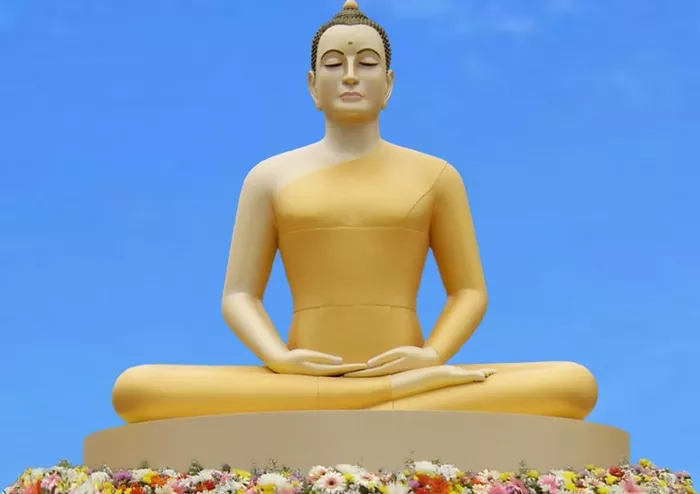The Sitting Buddha Statue is one of the most common and beloved forms of Buddhist art. It represents the Buddha in a seated posture, often shown in meditation or teaching. These statues are found in many Buddhist temples and homes around the world. Understanding their types, symbolism, and cultural importance helps us appreciate the deep spiritual messages they carry.
Types of Sitting Buddha Statues
There are various types of sitting Buddha statues. Each type has a unique posture and hand gesture, called a mudra, which tells a different story or teaching of the Buddha.
1. Meditation Buddha (Dhyana Mudra)
This is the most well-known sitting Buddha. The Buddha is shown sitting cross-legged with both hands resting on his lap, palms facing upward. This posture shows deep meditation and inner peace. It reminds us to practice calmness and focus in life.
2. Teaching Buddha (Dharmachakra Mudra)
Here, the Buddha’s hands are positioned to symbolize the turning of the Wheel of Dharma (teaching). This mudra means the Buddha is sharing his wisdom and guiding people on the right path.
3. Earth Touching Buddha (Bhumisparsha Mudra)
In this type, the Buddha sits with one hand reaching down to touch the earth. This gesture symbolizes his enlightenment under the Bodhi tree, calling the earth to witness his awakening.
4. Protection Buddha (Abhaya Mudra)
Though often shown standing, the protection mudra can appear in sitting statues too. The Buddha raises one hand with the palm facing outward, symbolizing protection, fearlessness, and peace.
Symbolism of the Sitting Buddha Statue
The sitting Buddha statue carries many symbolic meanings. These symbols help Buddhists and observers connect to Buddha’s teachings and inspire spiritual growth.
Calmness and Inner Peace
The sitting posture represents calmness. It encourages us to find stillness inside, no matter how busy life gets. This is a reminder that peace begins within ourselves.
Enlightenment and Wisdom
The Buddha sitting calmly symbolizes his enlightenment — the state of full understanding and freedom from suffering. It inspires us to seek knowledge and live wisely.
Compassion and Protection
Some sitting Buddha statues show gestures that offer protection and blessings. This reminds us of Buddha’s compassion for all living beings and his wish to protect them from harm.
Balance and Harmony
The cross-legged position shows balance between body and mind. It also signifies harmony between the spiritual and material world.
Cultural Significance of Sitting Buddha Statues
The sitting Buddha statue is important in many Buddhist cultures. It is not only a religious symbol but also a piece of art and history.
Use in Temples and Homes
In temples, sitting Buddha statues serve as the focus for meditation and rituals. Many Buddhists keep these statues in their homes to remind them of Buddha’s teachings every day.
Representation in Different Countries
Different Buddhist countries have their own styles of sitting Buddha statues. For example:
- Thailand: Buddha statues often have long earlobes and flame-like ushnisha (topknot).
- Japan: The statues may show more simple, serene facial expressions.
- India: Statues emphasize the original style with detailed robes and symbolic hand gestures.
Art and Architecture
Sitting Buddha statues inspire artists and architects. Their proportions, expressions, and mudras are carefully designed to evoke spiritual feelings and respect.
Common Materials Used for Sitting Buddha Statues
Sitting Buddha statues are made from many materials, each reflecting local traditions and availability.
Stone and Marble
Stone statues are strong and lasting. Marble Buddha statues are often polished and used in temples for their beauty.
Bronze and Metal
Bronze statues are popular in many parts of Asia. They allow fine details and are often gilded with gold to show respect and honor.
Wood
Wood statues are lighter and often hand-carved. They can be painted or left natural depending on the tradition.
Clay and Terracotta
In some regions, clay is used to create Buddha statues for special occasions or temporary shrines.
How to Interpret the Sitting Buddha Statue Meaning
Understanding the meaning behind sitting Buddha statues helps us connect to their teachings more deeply. For example, if you see a statue with hands on the lap, it likely represents meditation and calmness. If the hand touches the ground, it refers to Buddha’s enlightenment moment.
Practical Use and Respect for Sitting Buddha Statues
In Buddhist practice, sitting Buddha statues are treated with great respect. Here are some common guidelines:
Placement
The statue should be placed in a clean, elevated area. It is often positioned facing east or the main prayer area.
Offerings
Offerings such as flowers, incense, and candles are placed before the statue as a sign of respect and devotion.
Handling
Never place the statue directly on the floor or touch it disrespectfully. Treat it as a sacred object.
Conclusion
The Sitting Buddha Statue is much more than an artistic figure. It holds deep meaning and cultural importance across the Buddhist world. From the meditation posture to the earth-touching gesture, each form invites us to reflect on calmness, wisdom, compassion, and balance. Whether you are a practitioner or simply curious, understanding these statues enriches your appreciation of Buddhist art and philosophy.

